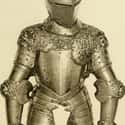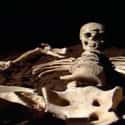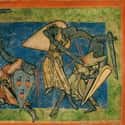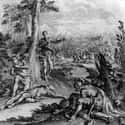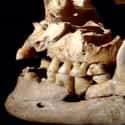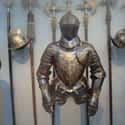-
(#1) The Battle Of Towton Was Fought During The Wars Of The Roses, A Long Struggle Between The Yorks And Lancasters
The Wars of the Roses consisted of a series of battles that lasted from 1455-1485. These were fought between two rival medieval English Houses, the Yorks and the Lancasters. The ins and outs of each battle, every rival to the throne, and all of the machinations that took place during the 30-year civil war boiled down to a single victory – the victory of Lancastrian Henry Tudor (soon Henry VII) over Yorkist Richard III at Bosworth Field. Henry married Elizabeth of York, which united the two houses, ended the war, and founded the Tudor dynasty. The Battle of Towton, which took place in 1461, occurred right in the middle of this ongoing series of skirmishes.
The name of the war represents the symbols of each house, a red rose for the Lancasters, a white for the Yorks. When Henry and Elizabeth bound the houses together, Henry combined the two into the famed Tudor Rose.
-
(#2) 15th-Century Weapons Were A Mix Of Tradition And Innovation, And Gunpowder Was Just Hitting The Field Of Battle
By the 15th century, medieval European weaponry had shifted to an infantry-focused use of hand weapons like axes, swords, and spears. The use of gunpowder technology was also becoming more common in medieval weapons with cannons and rudimentary handguns. Armor changed to handle new and more lethal weapons with heavier suits of armor replacing leather, simple chain mail, and piecemeal plates of metal that were used in the earlier Middle Ages.
-
(#3) The Battle Of Towton Was One Of The Bloodiest Of The 15th Century – 1% Of The English Population Was Killed That Day
The Battle of Towton was more or less removed from historical memory during the late 15th- and 16th-century Tudor Dynasty. The battle was fought in the north of England on March 29, 1491, and between 50,000 to 80,000 Englishmen were on the field of battle that day. Some estimates indicate that the two sides were evenly matched, while others claim the Lancasters had a numeric advantage.
As the battle waged over many hours, neither side gained a clear advantage, but in the wind and cold weather, the Lancastrians were forced to advance in order that their arrows reach the Yorkist line. The archers relented, and the two forces moved into hand-to-hand combat, with the momentum shifting in favor of the Lancastrian forces until York reinforcements arrived. The Lancaster line broke, and they retreated, with York fighters pursuing them and killing them as they fled. The death toll, according to contemporary sources, numbered 28,000 men, which was 1% of the entire population of England at the time, but the battle was a Yorkist victory.
-
(#4) Graves From Towton Reveal Some Seriously Hacked Bodies
The Battle of Towton was fought in a meadow, land that remained undeveloped until the 20th century. The discovery of a large grave at Towton in 1996 included 38 skeletons, 28 of them full males, ranging from roughly 20 to 50 years of age. Further excavation revealed as many as 51 skeletons, all of which showed signs of violent deaths.
The wounds found on the bones not only showed signs of (then) recent injury but also healed wounds, indicating the men were veterans who had finally run out of luck on that fateful Sunday in March. Only one skull did not show signs of a head injury; others showed as many as 13 wounds inflicted at Towton.
-
(#5) The Skull Of Towton 25 Tells A Story Of Pain – And Overkill
Towton 25, the 25th skull removed from the mass grave, showed signs of a blade wound that crosses its face diagonally across his eye, nose, and jaw. The blow that inflicted the damage was most likely given after his death, but analysis of his skull revealed that he suffered numerous blows while still alive. Scientists recreated the last hours of Towton 25's life and determined that he experienced at least five non-fatal blows to the head on the battlefield.
Towton 25 had clearly been engaged in hand-to-hand fighting and was slashed as a result. It was a lethal blow to the back of the head that ended Towton 25's life, but one of the two posthumous blows, the one that diagonally crossed his eye, nose, and jaw, is his legacy.
-
(#6) Though He Sustained Multiple Axe Blows To His Head, The First Five Didn't Kill Towton 25
According to an article in The Economist about the Battle of Towton, though his skull is riddled with punctures and signs of blunt force trauma, Towton 25 didn't die from the first five blows he sustained to the head:
"Towton 25 suffered eight wounds to his head that day. The precise order can be worked out from the direction of fractures on his skull: when bone breaks, the cracks veer towards existing areas of weakness. The first five blows were delivered by a bladed weapon to the left-hand side of his head, presumably by a right-handed opponent standing in front of him. None is likely to have been lethal.
The next one almost certainly was. From behind him someone swung a blade towards his skull, carving a down-to-up trajectory through the air. The blow opened a huge horizontal gash into the back of his head—picture a slit you could post an envelope through."
-
(#7) Towton 25 Probably Died When His Skull Fragments Entered His Brain
The brain trauma that resulted from a blow to the back of Towton 25's head most likely included fragments of his skull entering his brain. Archeologists and scientists posited that the blade that hit Towton 25's head from behind was swung in a upward manner, by a right-handed enemy.
All told, Towton 25 sustained eight wounds at the battle. The one that crossed his face was so deep that it cut to the back of his throat but, mercifully, he was already dead when that one was thrown.
-
(#8) Towton 25's Fellow Fighters Suffered Similar Fates
In addition to the slashing wounds and severe blows that Towton 25 experienced, the bones from the Towton graves show skulls with puncture wounds, evidence of blunt force trauma, incapacitating damage, and numerous fractures and other broken bones. There is no reason to believe that the men didn't die in the midst of the battle, as there are no signs of torture or any indications that the men were restrained as prisoners.
It's believed that the individuals in the Towton grave, because the pit itself is a mile from the battlefield proper, were killed late in the battle as the Yorkists pursued the fleeing Lancaster forces.
-
(#9) Battle Axes Were Fierce But Not Always Deadly Like Hollywood Wants You To Believe
The evidence of the Towton grave reveals how horrible battle in the Middle Ages could be, giving truth to what Hollywood has been portraying all along. The realities of weapons like the battle axe are much more complicated than the single-swing death-blows thrown in movies like Braveheart.
The numerous blows suffered by Towton 25, as well as the healed wounds found on the other bones from the battle, demonstrate the long-term suffering and pain suffered over and over again by medieval fighters.
-
(#10) Battle Axes Varied In Strength And Efficacy
There were numerous kinds of axes used during the medieval period, ranging from short hand-held axes to longer poleaxes, which often had a spike on the back of the blade. Anglo-Saxons and Vikings used axes with thicker-bearded or triangle heads, while in eastern Europe, axes had much thinner blades. Battle axes were made of various types of metal – or combinations of metal – but were not always strong enough to do much more than glance off of armor when just the curved blade was used.
By the 14th century, a longer staff weapon, like the poleaxe, was preferred to a shorter hand axe. The former allowed for more momentum and a harder swing, and with the spike, pierced plate armor in one shot.
New Random Displays Display All By Ranking
About This Tool
As we all know, the Middle Ages in Europe do not have firearms yet, and Europeans use cold steels during wars and conflicts. The severity of wars is no worse than that of World War I. The battle-axes were the most classic weapon in the Middle Ages and originally one of the most important tools in the daily life of the Nordic Vikings.
The battle-axes in medieval Europe can be said to be an indispensable and important part of the history of world weapons, which are heavy and more powerful. The random tool shows 10 details that show how brutal the Medieval battle axes in history.
Our data comes from Ranker, If you want to participate in the ranking of items displayed on this page, please click here.












